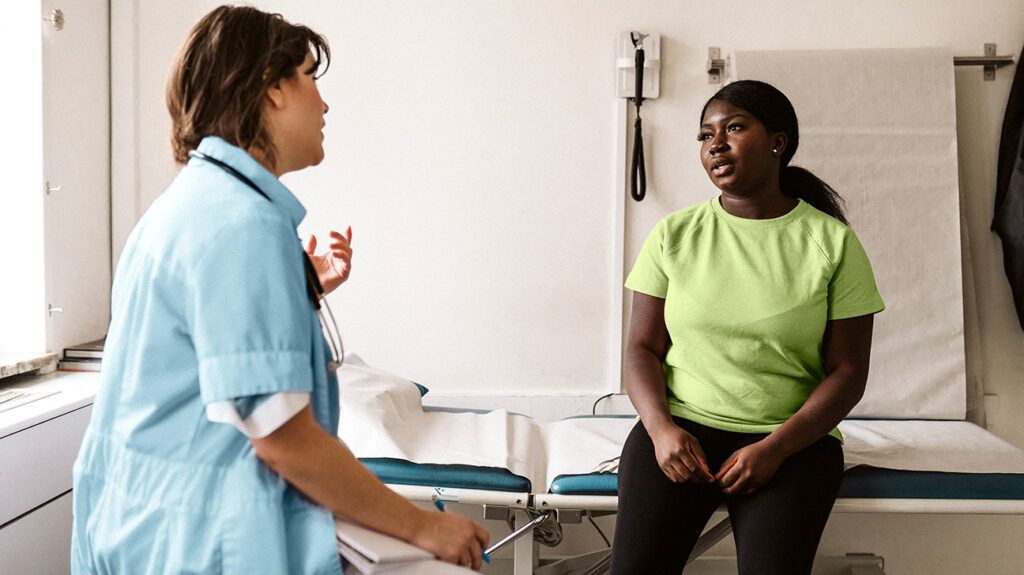Doctors may use a variety of tests and examinations to diagnose fertility issues in females. These can include gathering a detailed medical history, and imaging and hormone tests.
Fertility challenges affect females and males, although doctors use different methods of diagnosis for each.
If a female is unable to conceive, doctors may perform an infertility evaluation. This includes various examinations and tests to find the cause of fertility problems.
Assessing fertility risk factors or potential problems can help doctors to suggest appropriate treatments and interventions to help a person conceive.
This article looks at female fertility tests, self-testing, and symptoms of fertility challenges in females. It also looks at when to contact a doctor, treatments for female fertility issues, and support.
A note about sex and gender
Sex and gender exist on spectrums. This article will use the terms “male,” “female,” or both to refer to sex assigned at birth. Click here to learn more.

A doctor may order or perform several tests to diagnose and find the cause of female fertility challenges.
An initial screening of a female’s overall health
- a physical examination
- a pelvic examination
- a pelvic ultrasound
- a Pap test
- blood tests
- a breast examination
A doctor may also conduct or order some or all of the following fertility tests and procedures:
- Blood tests: A doctor may use blood tests to measure ovulation, thyroid function, levels of the hormones progesterone and prolactin, and ovarian reserve. Ovarian reserve refers to the ability of the ovaries to provide viable egg cells.
- Laparoscopy: A laparoscopy is a surgical procedure. During the procedure, a doctor inserts a viewing instrument — a laparoscope — through a small incision in the abdomen. The procedure allows doctors to view the female reproductive organs. Doctors can also treat certain causes of fertility issues during the procedure, such as blockages in the fallopian tubes.
- X-ray hysterosalpingogram: During this procedure, a healthcare professional injects radiographic dye into the cervix. The movement of the dye is visible through X-ray fluoroscopy and can reveal causes of female fertility problems such as blocked fallopian tubes.
- Hysteroscopy: During a hysteroscopy, a doctor inserts a long, thin camera — a hysteroscope — into the uterus through the vagina. This procedure
may reveal causes of fertility issues such as polyps, scarring in the uterus, or uterine fibroids. - Transvaginal ultrasound: Doctors may use a transvaginal ultrasound to view the ovaries and uterus. The imaging scan uses sound waves to produce images of the female reproductive organs.
- Saline sonohysterogram: This procedure involves a doctor injecting saline into the cervix to fill the uterine cavity. This can
help doctors view the inner lining of the uterus more clearly during a transvaginal ultrasound.
Women’s health resources
Visit our dedicated hub for more research-backed information and in-depth resources on women’s health.
Self-testing for female fertility
The laboratory may use the sample to analyze factors that can affect female fertility, including ovarian reserve tests, such as antimüllerian hormone (AMH) and follicle-stimulating hormone (FSH), and hormone tests, such as thyroid stimulating hormone (TSH), prolactin, and estradiol.
There are potential advantages and disadvantages to self-testing.
Advantages
- at-home tests provide greater access to testing
- the tests are noninvasive
- the process of self-testing allows for confidentiality
- the process may provide empowerment and autonomy
- self-testing is convenient
- self-testing may be more cost-effective than clinical testing
- the results may help a person receive early medical intervention
Disadvantages include:
- tests are limited to hormonal testing without an ultrasound, which doctors
typically recommend - results may have limited diagnostic value
- there is a lack of regulation for at-home fertility tests
- results may be invalid or unreliable, depending on the laboratory’s methodologies
- a person may have to interpret their own results
- marketing strategies for self-testing may be misleading
- results may lead to a lack of medical intervention or overtreatment
A female may want to undergo testing for infertility if they have not conceived within a year of having regular unprotected sex.
Signs that may indicate infertility in females include:
A person may want to contact a doctor for fertility testing if they have not conceived after a year of trying. Females aged 36 and over may want to contact a doctor sooner to test for possible causes of infertility.
Treatments for female fertility challenges vary depending on the cause. They can include:
- fertility medication to prompt or regulate ovulation
- assisted conception, such as in vitro fertilization (IVF) and intrauterine insemination (IUI)
- surgery to treat physical and structural causes of infertility, such as the removal of scars from the womb, and fallopian tube repair
Although experiencing fertility challenges can cause a person to feel isolated, it is a widespread concern. In the United States, about
A person can find support and connect with others with similar experiences through online and in-person support groups.
The National Infertility Association RESOLVE can help people find local peer- and professionally-led support groups.
A person may also want to contact a mental health professional for mental health treatment such as psychotherapy.
A person may want to contact a doctor for fertility testing if they have not conceived within a year of trying.
Doctors can use several tests to diagnose fertility problems in females. These include various tests to assess the levels of certain hormones, such as progesterone and prolactin, and imaging tests to view the female reproductive organs.
Treatment for female fertility problems varies depending on the cause. It may involve fertility medication, assisted conception, or surgery.
